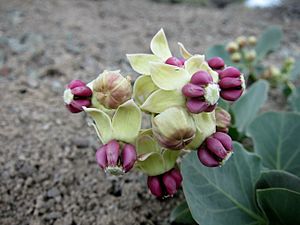Jewel milkweed facts for kids
Quick facts for kids Jewel milkweed |
|
|---|---|
 |
|
| Conservation status | |
| Scientific classification | |
| Genus: |
Asclepias
|
| Species: |
cryptoceras
|
Asclepias cryptoceras is a type of milkweed plant. It has several common names like jewel milkweed, pallid milkweed, Humboldt Mountains milkweed, and cow-cabbage. This plant grows naturally in the Great Basin area of western North America. You can often find it in many different places, especially in dry areas.
This plant is a perennial herb, which means it lives for more than two years. It usually grows low to the ground or hangs down. It grows from a thick, woody root that looks a bit like a rhizome. Its leaves are thick and shaped like a circle or a heart. They grow in pairs on the short stem.
Contents
What Does Jewel Milkweed Look Like?
The flowers of the jewel milkweed grow in a cluster. Each small flower has bright to dull pink parts in the middle, called hoods. Around these hoods are pale-colored petals that bend backwards. After the flowers, the plant produces a fruit called a follicle. This fruit stands upright on a small stalk.
Where Does Jewel Milkweed Grow?
Jewel milkweed is found in the Great Basin region. This area includes parts of states like Nevada, Utah, and California. It likes dry places, so you might see it in deserts or rocky areas. It's tough and can grow in many different kinds of soil.
Traditional Uses of Jewel Milkweed
The Northern Paiute are Native Americans who live in the Great Basin. They traditionally used the jewel milkweed plant for various purposes. They would prepare the roots to help with headaches and sores. The milky sap, called latex, was used for skin problems like ringworm. This shows how people learned to use plants around them for their health.
See also
 In Spanish: Asclepias cryptoceras para niños
In Spanish: Asclepias cryptoceras para niños


